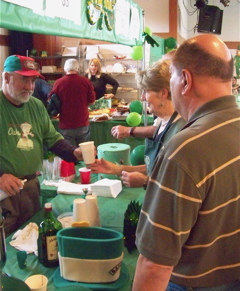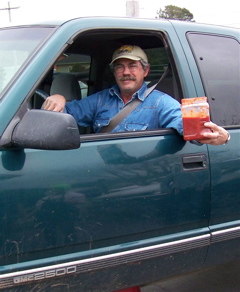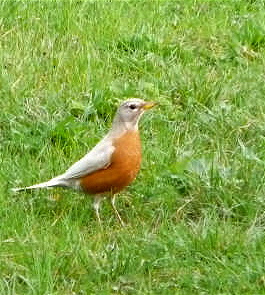Sun 15 Mar 2009
Two warning signs of Spring
Posted by DavidMitchell under General News, Point Reyes Station, Wildlife
[4] Comments

Father Jack O’Neill (center), pastor of Sacred Heart Parish, flanked by Marin County Fire Capt. Todd Overshiner and Mike Krillelea of San Rafael, jokes with guests at today’s barbecue.
 A warning sign of Spring: Hundreds of people showed up at the Dance Palace this afternoon for Sacred Heart Church’s annual St. Patrick’s Day Barbecue.
A warning sign of Spring: Hundreds of people showed up at the Dance Palace this afternoon for Sacred Heart Church’s annual St. Patrick’s Day Barbecue.

West Marin Irish Music Players, who practice from 7 to 9 p.m. Mondays at West Marin School, entertained guests.
 A volunteer bartender at the St. Patrick’s Day Barbecue, Mark Allen (left) of Inverness Park, takes an order for an Irish coffee.
A volunteer bartender at the St. Patrick’s Day Barbecue, Mark Allen (left) of Inverness Park, takes an order for an Irish coffee.
Mark was the lead cameraman for a 60 Minutes segment, scheduled to be aired at 7 p.m. this evening, on “slow-food” advocate Alice Waters of Chez Panisse.

Some 446 chicken dinners were served inside the Dance Palace while outside the community center, Drakes Bay Oyster Company barbecued 1,000 oysters as part of the fundraiser. In the foreground shucking oysters are company owner Kevin Lunny (right) and John Aucoin of Inverness Park.

Anastacio Gonzalez of Point Reyes Station, head of technical maintenance at West Marin School, provided his special barbecue sauce for the oysters. Here he checks to see whether he’ll need to make more when he goes home.
Almost 30 years ago, Anastacio devised the recipe while barbecuing oysters at the old Nicks Cove restaurant. He then took it to the former Barnaby’s restaurant in Inverness (now Thepmonggon Thai restaurant), and later to Tony’s Seafood. By now, barbecuing with sauce inspired by his recipe is a standard way of preparing oysters in the Tomales Bay area.

Today’s rain held off until just after the barbecue finished, which was good because both the chickens and oysters were barbecued outdoors and because many guests chose to eat them picnic style on the Dance Palace’s front lawn. With Spring only five days off, ranchers are hoping to squeeze the last bit of moisture out of winter. When the current series of rainstorms began, my neighbor Jay Haas shot this photo of a stockpond overflowing on the Giacomini family’s land next to ours.
 Another warning sign of Spring: The gloomy days of winter are supposed to be over “when the red, red robin comes bob, bob, bobin’ along.” But at Jay’s home this year, the first robin of Spring is not “red, red” but partially albino. (Photo by Jay Haas)
Another warning sign of Spring: The gloomy days of winter are supposed to be over “when the red, red robin comes bob, bob, bobin’ along.” But at Jay’s home this year, the first robin of Spring is not “red, red” but partially albino. (Photo by Jay Haas)
“For some reason, albinism and partial albinism have been recorded in robins more than any other wild bird species,” the website American Robin reports.
“One study found that 8.22 percent of all albino wild birds found in North America were robins. But only about one robin in 30,000 is an albino or partial albino. Most records of robins with albinism are only partial albinos, which of course live longer than total albinos.”
As American Robin explains, totally albino birds have no pigment in their irises and retinas to protect their eyes from sunlight, and many eventually go blind.

I just spotted one in Canton, MI on April 2012
I assume you’re referring to albino robins.
I have one hanging around my yard the past few weeks – seen it just a few minutes ago again
In June of 2012, I had one in my back yard here in northern Michigan